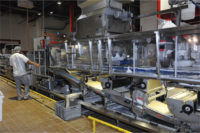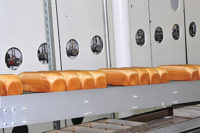Going for LEED Silver certification, Blue Diamond Growers’ new, state-of-the-art almond production plant in Turlock, CA, features nearly 200,000 sq. ft. of sophisticated almond technology, setting new standards of excellence for food safety, processing and building innovation.
Blue Diamond Growers’ new almond-processing plant in Turlock, CA, will be its first facility to achieve Leadership in Energy & Environ-mental Design (LEED) Silver certification later this year. The nearly 200,000-sq.-ft. facility epitomizes best practices for almond production in the U.S. Open since 2013, the plant is thought to be the largest single almond investment in the company’s 104-year history.
Representing what Sacramento, CA-based Blue Diamond Growers calls Phase One of a 15-year growth strategy developed about three years ago, the plant in Turlock joins other Blue Diamond Growers’ processing plants in Sacramento and Salida, CA. While the Salida facility processes roughly 1 million lb. of raw almonds a day, nearly all of the production
at Turlock serves the company’s global ingredient manufacturing business. This is part of the Phase One plan to supply ingredient almonds to major customers and global consumer product groups.
To cut waste, streamline processes and maximize value, Blue Diamond Growers took a lean approach in the planning and designing of the facility. Production begins after raw materials enter the receiving area to be processed, and move in a linear flow through a three-room production area. The products are then packaged and transferred to the shipping area, all on one floor. While not a standard required by the industry, the Turlock almond-processing plant is perhaps the first to completely separate raw materials from finished goods, which helps eliminate any chance for cross-contamination and improves food safety.
The processing facilities in Sacramento use gravity-fed material systems that operate within multistory buildings. “Moving away from a gravity-feed system was a key consideration for Turlock, [since] trying to move materials to each of the floors can be difficult and energy consuming,” says Bruce Lish, general manager, industrial operations.
Three lines so far
The Turlock production area currently operates one natural product line (brown almonds with skin) and two blanched almond lines where the skin is removed. Each of the lines is positioned in its own 50-ft.-wide bay, adjacent to the others. “The three lines are set up to produce whole almonds, as well as sliced, slivered or diced product of different specifications, by engaging or bypassing components of the cutting system,” explains Ulli Thiersch, plant manager and director of projects and construction, industrial operations.
The production lines boast several advantages over the previous system designs, including the ability to operate continuously, instead of in batches. The lines can also switch from dicing, slicing or slivering practically on-the-fly, whereas other production lines had to shut down and retool for product changeovers.
There are four different types of cutting finishes integrated within each of the three lines, says Thiersch. “The lines are integrated with five packaging lines, so the plant can produce any type of product in any type of packaging, and switch to a different product or packaging type at a moment’s notice.”
Process controls feature Allen Bradley 700 systems with local programmable logic controllers (PLCs), and an Ethernet backbone through the plant, which is fully automated, Thiersch points out.
Blue Diamond’s own fleet of trucks deliver almond meats from the Sacramento or Salida complexes to Turlock in sealed, bulk 2,000-lb. gaylord containers (these trucks drop off raw materials to the receiving area and drive to the opposite end of the plant to pick up finished goods for transport back to the Sacramento site, for example, to maximize transportation efficiency).
The bulk containers are hydraulically lifted by mass-flow bins dedicated to each processing line that discharge the almonds onto a mass-flow, loss-in-weight feeder, equipped with a vibratory conveyor. The PLC controls monitor the flow of the product onto the conveyors below, usually at rates from a reported 1,000-10,000 lb./hr.
Almonds then convey through an opening in the wall into a “wet” processing area, the first stage of the production process. This is where pasteurization and a pathogen kill take place in a completely enclosed and separate area from the dry-production areas. Natural almond processing involves pasteurization with steam, while products targeted for blanching and skin removal are scalded with water. With natural almonds, the challenge is pasteurizing with steam, while keeping the nuts’ skin intact.
‘Skin treatments’
The project team developed a low-moisture thermal process (basically, dry steam), which kills micro-organisms on the surface of the nuts but keeps the moisture low enough to avoid damaging the skin. Steamy almonds then enter an oven to raise their temperature. The enclosed system combines a balance of steam delivery, temperature, belt speed control and a host of other factors.
In the blanching process, the almonds are submerged in a bath of scalding water, which not only pasteurizes them but raises their temperature, so they’re more pliable. According to the Technical Expert Review Panel (TERP), a California agency that governs the definition of pasteurization, blanching processes must submerge the nuts in 190-deg.-F water for a minimum of two minutes (all three lines have been tested and certified by TERP for efficacy and meet or exceed its mandatory requirements). The almonds’ final moisture level can be no higher than 6% to ensure that they are safe for consumption and won’t decay or spur bacteria growth when stored and handled properly.
Next, the pasteurized almonds convey through another opening in the wall to a central processing area of the plant, where the Ready-to-Eat (RTE) section is located. Almonds treated with scalding water actually remain in the scalder as they move into the sterile room. These almonds drop into an enclosed de-skinning unit that features a set of special rubber-covered rollers to strip off their softened skin.
Natural or blanched almonds are then transported on their lines through separate foreign contaminant-detection systems and into an oven for temperature and moisture conditioning before they reach any required process cutting. A small team of quality-control personnel stationed at the end of each processing line manually checks the almonds for damage or skins remaining on blanched product. The control system is designed to stop and discharge product if any variable violates the set parameters.
Slicing and dicing or slivering
Then, the almonds can be sliced, diced and slivered in one of three different ways. Product exiting the processing line is conveyed to a cutting system, and move down channels that direct them to a particular cutting device or bypass this if whole almonds are required.
“Hot and moist almonds are ideal for slicing, where pliability provides a little give in them for a smoother cut,” notes Thiersch. “Almonds for dicing are kept cool and dry so the kernel explodes and breaks apart.”
The finished almond product—whether whole or cut—then conveys up and out of the main RTE processing area through another wall and into the final RTE packaging/processing zone, which is located on a mezzanine level above the packing and shipping section. Product is moved by an air-cooled vibratory conveyor to keep it at its proper temperature. Then, it conveys to a material-handling unit that dispenses it into one of five bulk scale/dribble weigh scale packaging systems in the packaging and shipping station. Almond product is then packaged into 25- or 50-lb. boxes or 2,000-lb. totes or SuperSacks, and is weighed for accuracy before being sealed, labeled and palletized.
No roasting is done in Turlock yet, says Lish. “Packages are briefly staged in the shipping area, and are shipped out to customers or to our Sacramento plant for further processing.”
Control systems measure product flow rates, temperatures, moisture, bin levels and line speeds, to provide feedback that keeps production on task. Touchscreen panels are positioned throughout the plant to provide instant access to current information and allow personnel to make adjustments to utilities, process equipment and packaging systems.
No doubt, the new operation is giving Blue Diamond Growers just what it needs to succeed in producing the finest almond products today and tomorrow.
Editor’s Note: Photography for and substantial portions of this article were written for and published in the April 2014 issue of our sister publication, Food Engineering. Snack Food & Wholesale Bakery wishes to thank FE for its assistance.








